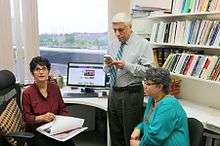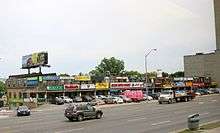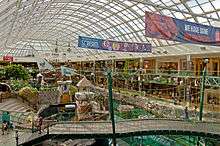Iranian Canadians
Iranian Canadians or Persian Canadians[2][3] are citizens of Canada whose national background is traced from Iran or are people possessing Iranian and Canadian dual citizenship.[4] From the 2016 Canadian census, the main communities can be found in Southern Ontario, British Columbia, and Quebec. The vast majority, however, live in northern suburbs of Toronto such as Richmond Hill, Vaughan, Markham, and Thornhill, and in certain municipalities of Vancouver, including North Vancouver, West Vancouver, Burnaby, and Coquitlam. As of 2016 a total of 97,110 Iranians reside in the Greater Toronto Area,[5] 46,255 in the Greater Vancouver Area,[6] and 23,410 in the Greater Montreal Area,[7] with the remainder spread out in the other major cities of Canada, based on the 2016 Canadian Census. These numbers represent the people who stated "Iranian" as their single or joint ethnic origin in the census survey.
| Total population | |
|---|---|
| 210,405 (2016 census)[1] | |
| Regions with significant populations | |
| Richmond Hill, Toronto, North Vancouver, Montreal, Ottawa | |
| Languages | |
| Persian, Canadian English, Canadian French Azerbaijani, Armenian, Kurdish, and other languages of Iran. (see Languages of Iran). | |
| Religion | |
| Predominantly Twelver Shi'a Islam Minorities include Bahá'í Faith, Christianity (Protestantism and Catholicism), Judaism, Sunni Islam and Zoroastrianism |
Terminology
Iranian-Canadian is used interchangeably with Persian-Canadian,[8][9][10][11] partly due to the fact[12] that, in the Western world, Iran was known as "Persia". On the Nowruz of 1935, Reza Shah Pahlavi asked foreign delegates to use the term Iran, the endonym of the country used since the Sasanian Empire, in formal correspondence. Since then the use of the word "Iran" has become more common in the Western countries. This also changed the usage of the terms for Iranian nationality, and the common adjective for citizens of Iran changed from "Persian" to "Iranian". In 1959, the government of Mohammad Reza Pahlavi, Reza Shah Pahlavi's son, announced that both "Persia" and "Iran" could officially be used interchangeably.[13] However the issue is still debated today.[14][15]
There is a tendency among Iranian-Canadians to categorize themselves as "Persian" rather than "Iranian", mainly to dissociate themselves from the Islamic regime of Iran which is in charge since the 1979 Revolution and the negativity associated with it, and also to distinguish themselves as being of Persian ethnicity, which comprise about 65% of Iran's population.[8][16] While the majority of Iranian-Canadians come from Persian backgrounds, there is a significant number of non-Persian Iranians such as Azeris[17][18][19] and Kurds within the Iranian-Canadian community,[16][20] leading some scholars to believe that the label "Iranian" is more inclusive, since the label "Persian" excludes non-Persian minorities.[16] The Collins English Dictionary uses a variety of similar and overlapping definitions for the terms "Persian" and "Iranian".[21][22]
Notable Canadians of Iranian descent

Academia

- Payam Akhavan, pioneer in international criminal law and leading human rights advocate; McGill University[23]
- Kaveh Farrokh, historian
- Hamid Reza Habibi, Cardiologist; University of Calgary
- Ramin Jahanbegloo, philosopher and university professor
- Ali Khademhosseini, Associate Professor of Medicine; Harvard-MIT Division of Health Sciences and Technology[24]
- Shahrzad Mojab, Professor of Leadership, Higher and Adult Education; University of Toronto
- Reza Zadeh, computer scientist; Stanford University
Art and literature
- Hossein Amanat, architect, urban designer
- Reza Baraheni, novelist, poet, critic, and political activist
- Jian Ghomeshi, member of Moxy Früvous; former host of CBC's play; former host of Q on CBC Radio 1
- Siamak Hariri, architect
- Ramin Karimloo, West End performer, playing the lead role in Andrew Lloyd Webber's The Phantom of the Opera and the sequel Love Never Dies
- Navid Khonsari, video game, film and graphic novel creator, writer, director and producer
- Fariborz Lachini, music composer
- Nima Mazhari, painter, photographer and husband of ex-Olympic biathlete Myriam Bédard, convicted and sentenced in June 2007 for stealing paintings from the late painter Ghitta Caiserman
- Sanaz Mazinani, photographer and curator
- Marina Nemat, author
- Ghazal Omid, nonfiction political writer, nonfiction children's book writer, speaker, NGO executive
- Fariborz Sahba, architect
- Parviz Tanavoli, sculptor and painter
Beauty pageants
- Nazanin Afshin-Jam, Miss Canada 2003, first runner-up of Miss World 2003, actress, singer-songwriter, human rights activist; wife of former Canadian Defence Minister Peter MacKay
- Ramona Amiri, Miss World Canada 2005, semifinalist of Miss World 2005
- Samantha Tajik, Miss Universe Canada 2008
Business

- Ghermezian family, billionaire shopping mall developers
- Hassan Khosrowshahi, founder of Future Shop
- Karim Hakimi, founder of Hakim Optical
- Michael Latifi, founder of Sofina Foods Ltd and owner of Nidala (BVI) Limited which holds a share in Mclaren.
- Shahrzad Rafati, founder of BroadbandTV Corp
- Shahin Assayesh, publisher
Crime
- Omid Tahvili, kingpin and international fugitive
Entertainment
- Mehdi Sadaghdar, YouTube personality, electrical engineer
Journalism

Various Persian-language media (including TV and newspapers) are active in Canada, including Shahrvand and Salam Toronto, which cover local events as well.[25]
- Maziar Bahari, journalist
- Farid Haerinejad, CBC former producer, documentary maker and current ِِEditor in Chief of Radio Zamaneh
- Zahra Kazemi, photojournalist
- Nikahang Kowsar, cartoonist
- Touka Neyestani, cartoonist
Politicians
- Ali Ehsassi, Federal Liberal MP for Willowdale, lawyer
- Majid Jowhari, Federal Liberal MP for Richmond Hill, engineer
- Amir Khadir, Québec solidaire Former MNA for Mercier, microbiologist
- Reza Moridi, Ontario Liberal Former MPP for Richmond Hill, physicist, engineer
Sport
See also
References
- Canada, Government of Canada, Statistics (2017-02-08). "Census Profile, 2016 Census - Canada [Country] and Canada [Country]". www12.statcan.gc.ca.
- "PM meets with representatives of the Persian-Canadian community - Prime Minister of Canada". Pm.gc.ca. 2009-08-04. Archived from the original on 2012-03-06. Retrieved 2012-09-10.
- "Nazanin Afshin-Jam: TD Bank 'Misinterpreting' Iran Sanctions In Shutting Persian-Canadians' Accounts". HuffingtonPost.ca. 2012-09-12. Retrieved 2015-04-27.
- "Ethnic origins, 2006 counts, for Canada, provinces and territories - 20% sample data". Statistics Canada. 2008-04-02. Retrieved 2009-10-11.
- Canada, Government of Canada, Statistics. "Census Profile, 2016 Census - Toronto [Census metropolitan area], Ontario and Ontario [Province]". www12.statcan.gc.ca. Retrieved 2018-03-13.
- Canada, Government of Canada, Statistics. "Census Profile, 2016 Census - Vancouver [Census metropolitan area], British Columbia and British Columbia [Province]". www12.statcan.gc.ca. Retrieved 2018-03-13.
- Canada, Government of Canada, Statistics. "Census Profile, 2016 Census - Montréal [Census metropolitan area], Quebec and Quebec [Province]". www12.statcan.gc.ca. Retrieved 2018-03-13.
- Daha, Maryam (September 2011). "Contextual Factors Contributing to Ethnic Identity Development of Second-Generation Iranian American Adolescents". Journal of Adolescent Research. 26 (5): 543–569. doi:10.1177/0743558411402335.
... the majority of the participants self-identified themselves as Persian instead of Iranian, due to the stereotypes and negative portrayals of Iranians in the media and politics. Adolescents from Jewish and Baha'i faiths asserted their religious identity more than their ethnic identity. The fact Iranians use Persian interchangeably is nothing to do with current Iranian government because the name Iran was used before this period as well. Linguistically modern Persian is a branch of Old Persian in the family of Indo-European languages and that includes all the minorities as well more inclusively.
- Nakamura, Raymond M. (2003). Health in America: A Multicultural Perspective. Kendall/Hunt Pub. p. 31. ISBN 978-0-7575-0637-6.
Iranian/Persian Americans – The flow of Iranian citizens into the United States began in 1979, during and after the Islamic Revolution.
- Zanger, Mark (2001). The American Ethnic Cookbook for Students. ABC-CLIO. p. 213. ISBN 978-1-57356-345-1. Retrieved December 21, 2016.
- Racial and Ethnic Relations in America, Carl Leon Bankston,"Therefore, Turkish and Iranian (Persian) Americans, who are Muslims but not ethnically Arabs, are often mistakenly..", Salem Press, 2000
- Darya, Fereshteh Haeri (2007). Second-generation Iranian-Americans: The Relationship Between Ethnic Identity, Acculturation, and Psychological Well-being. ProQuest. pp. 3–4. ISBN 978-0-542-97374-1. Retrieved 21 December 2016.
According to previous studies, the presence of heterogeneity is evident among Iranian immigrants (also known as Persians – Iran was known as Persia until 1935) who came from myriads of religious (Muslim, Christian, Jewish, Armenian, Assyrian, Baha'i and Zoroastrian), ethnic (Turk, Kurds, Baluchs, Lurs, Turkamans, Arabs, as well as tribes such as Ghasghaie, and Bakhtiari), linguistic/dialogic background (Persian, Azari, Gialki, Mazandarani, Kurdish, Arabic, and others). Cultural, religious and political, and various other differences among Iranians reflect their diverse social and interpersonal interactions. Some studies suggest that, despite the existence of subgroup within Iranian immigrants (e.g. various ethno-religious groups), their nationality as Iranians has been an important point of reference and identifiable source of their identification as a group across time and setting.
- Yarshater, Ehsan Persia or Iran, Persian or Farsi Archived 2010-10-24 at the Wayback Machine, Iranian Studies, vol. XXII no. 1 (1989)
- Majd, Hooman, The Ayatollah Begs to Differ: The Paradox of Modern Iran, by Hooman Majd, Knopf Doubleday Publishing Group, September 23, 2008, ISBN 0385528426, 9780385528429. p. 161
- Frye, Richard Nelson (2005). Greater Iran: A 20th-century Odyssey. Mazda. ISBN 9781568591773. Retrieved December 21, 2016.
- Bozorgmehr, Mehdi (2009). "Iran". In Mary C. Waters; Reed Ueda; Helen B. Marrow (eds.). The New Americans: A Guide to Immigration since 1965. Harvard University Press. p. 469. ISBN 978-0-674-04493-7.
- Svante E. Cornell (20 May 2015). Azerbaijan Since Independence. Routledge. p. 7. ISBN 978-1-317-47621-4.
- Barbara A. West (1 January 2009). Encyclopedia of the Peoples of Asia and Oceania. Infobase Publishing. p. 68. ISBN 978-1-4381-1913-7.
- James Minahan (1 January 2002). Encyclopedia of the Stateless Nations: S-Z. Greenwood Publishing Group. p. 1766. ISBN 978-0-313-32384-3.
- Elizabeth Chacko, Contemporary ethnic geographies in America // Ines M. Miyares, Christopher A. Airriess (eds.), Rowman & Littlefield, 2007, pp. 325–326
- "Collins English Dictionary – Complete & Unabridged 11th Edition". Collinsdictionary.com. Retrieved September 4, 2012.
- "Definition of "Persian"". Collins English Dictionary. Retrieved January 12, 2016.
- "Payam Akhavan". HuffingtonPost.com. Retrieved 2017-08-20.
- Archived 2012-04-15 at the Wayback Machine
- "Shahrvand Profile". Canadian Minority Media Database. 2014-05-08. Retrieved 2014-06-25.